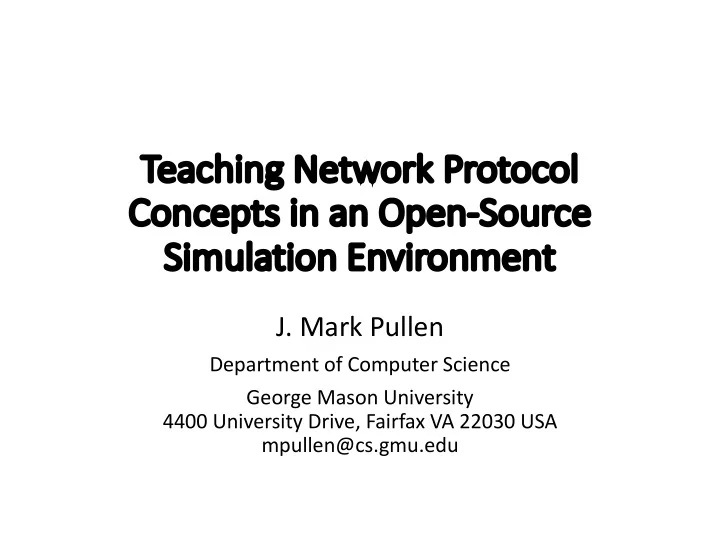

Te Teaching Network Protocol Con Concepts in an Open-Sou Source ce Si Simulation on Environ onment J. Mark Pullen Department of Computer Science George Mason University 4400 University Drive, Fairfax VA 22030 USA mpullen@cs.gmu.edu
Ov Overview • Philosophy behind Network Workbench • Teaching network protocols using simulation • Java Network Workbench 2 • Features • Structure • Available exercises • JNW2 and constructivism • Grade outcomes/conclusion Mark Pullen Teaching Network Protocol Concepts 2 in an Open Source Simulation Envrionment
Ph Philos osop ophy b behind N Networ ork W Wor orkbench • We’ve been using simulation as a teaching tool for network protocols since 1993 • Students learn more by solving problems • Specifically how network protocols work • We provide scaffolding for all the “busy work” of programming • They program the core algorithms • Simulation provides reproducible results • Java Network Workbench 2 (JNW2) replaces Network Workbench (which was C++ based) • Open source software for teaching Mark Pullen Teaching Network Protocol Concepts 3 in an Open Source Simulation Envrionment
JN JNW2 2 and nd Co Cons nstr truc ucti tivism JNW2 is rooted in constructivist philosophy as laid out by Savery and Duffy (1995): • Anchor all learning activities to a larger task or problem • Support the learner in developing ownership for the overall problem or task • Design an authentic task • Design the task and the learning environment to reflect the complexity of the environment they should be able to function in at the end of learning • Give the learner ownership of the process used to develop the solution • Design the learning environment to support and challenge the learner’s thinking • Encourage testing ideas against alternative views and alternative contexts • Provide opportunity for and support reflection on both the content learned and the learning process Mark Pullen Teaching Network Protocol Concepts 4 in an Open Source Simulation Envrionment
Wh What is Provided ed in JNW2 W2 • Overall environment packaged for NetBeans • Also usable in Eclipse • Java offers lower complexity and student familiarity • At the heart, a Discrete Event Simulation (DES) engine • All activity has known time (or distribution) • Each event can trigger another event • Java classes to support all functions • Good quality programming • Stack patterned after the Internet Protocol Suite • In the middle of key stack layers, place for student to add code • With algorithm to be implemented, in comments • Must interoperate with open-source code provided • Example data “email” and network structure Mark Pullen Teaching Network Protocol Concepts 5 in an Open Source Simulation Envrionment
Ja Java Netw twork k Workbe kbenc nch h 2 2 Featur tures • Like the Internet, node addresses have a local and global part • And there is a Data Link layer underneath • DES steps through the simulation visibly, in “ticks” • nextEvent() pulls next scheduled action from list • Stochastic option: an event can have predictable time or last for time drawn at random from a distribution • But the random number generator seed always follows the same pattern so the outcome is predictable • Network can be viewed graphically Mark Pullen Teaching Network Protocol Concepts 6 in an Open Source Simulation Envrionment
Ja Java Netw twork k Workbe kbenc nch h 2 2 Str truc uctur ture Mark Pullen Teaching Network Protocol Concepts 7 in an Open Source Simulation Envrionment
Ja Java Ne Networ ork k Wor orkb kbench 2 2 Ex Exercises • Data Link Layer • bit stuffing/unstuffing • error detection • Carrier Sense Multiple Access with Collision Detection • Network Layer • topology matrices • network layer routing • Transport Layer • reliable transport layer • slow-start sending end window Mark Pullen Teaching Network Protocol Concepts 8 in an Open Source Simulation Envrionment
Mo More Exercises Planned • token passing local area networks ? • network layer routing information distribution • multicast networking • network security • application layer message handling • mixture of traffic types Mark Pullen Teaching Network Protocol Concepts 9 in an Open Source Simulation Envrionment
Gr Grade O Outcom omes a and C Con onclusion on • ABET requirements stimulated collecting outcomes; students score a letter grade higher on JNW2-related exam questions Semester Number of JNW2- Not JNW2- Students related related Fall 2009 26 64.6 61.3 Spring 2014 30 67.7 56.2 Fall 2014 22 78.0 72.0 Spring 2016 35 78.1 63.5 Overall 113 72.2 62.7 • Students enjoy the projects and learn more • JNW2 is available http://netlab.gmu.edu/JNW2 • Solutions available by faculty request on department letterhead Mark Pullen Teaching Network Protocol Concepts 10 in an Open Source Simulation Envrionment
Recommend
More recommend